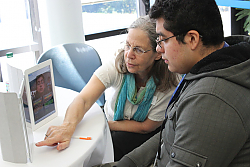by Linda Hecker, M.Ed.
A headline on the website for the Yale Center for Dyslexia and Creativity caught my attention recently: “A New Understanding: A Giant Step Forward--Yale’s Policy Granting Partial Waivers of the Foreign Language Requirement to Students who are Dyslexic”
As a rationale, the Yale Center article cites “the negative influence of …profound and persistent difficulties in learning a foreign language… [T]he policy has benefited the university, the foreign language department, and the students.”
Waivers or course substitutions (such as Latin, American Sign Language, or linguistics courses) may be appropriate and welcomed by some. However, our increasingly global economy highly values intercultural understanding. It’s worth considering alternative approaches, especially for a population whose opportunities may already have been limited in many areas.
There’s little dispute about the challenges faced by many students learning a foreign language, although some may be surprised to learn this is true even for highly accomplished students who attend an elite institution like Yale University. More than 20 years of research, spearheaded by the team of Richard Sparks and Lenore Ganschow, has established the Linguistic Coding Hypothesis as a compelling explanation for why so many students have difficulty in foreign language classrooms.
Some of these students have diagnosed learning disabilities; others don’t. However, they share common difficulties in processing elements of language, most notably the sound structure (phonology) of language. This sometimes manifests in delayed early speech and difficulties with articulation and auditory processing of language. These problems become magnified when learning to read, spell, and write, as this requires students to match the sounds of words with letters.
The same set of challenges return to haunt students when they begin foreign language study. Learning a second language loads heavily on the ability to discriminate, remember, and articulate a new set of unfamiliar speech sounds. These difficulties are compounded by traditional approaches used by most foreign language classes: an aural-oral immersion approach which overtaxes the reduced phonological processing ability seen in struggling students.
In spite of these roadblocks, we have good evidence that foreign languages can be successfully taught to these struggling students. Landmark College, for one, has offered multi-semester sequences in Spanish, French, and American Sign Language for over 20 years, bringing the manifold benefits of second language learning to students who may have failed previous attempts. These students not only grow in confidence about their language ability but often reap enormous personal rewards through study abroad programs that offer immersion experiences in culture and language.
Rather than offering foreign language waivers as the default option for struggling students, schools and colleges should be developing programs that expand options by using approaches that recognize and compensate for student difficulties, such as the programs at Landmark College, University of Colorado, American University, and others.
For further reading on this topic:
Downey, D., & Snyder, L. (2001). Curricular accommodations for the college student with language learning disabilities. Topics in Language Disorders. 21(2), 55-67.
Leons, E. (2013). The learner - diverse and differently abled: Understanding the learning journey. The Language Educator. 8(4), 32 -34.
Sparks, R. (2009). If you don’t know where you’re going, you’ll wind up somewhere else: The case of “foreign language learning disability.” Foreign Language Annals. 42(1), 7-26.

